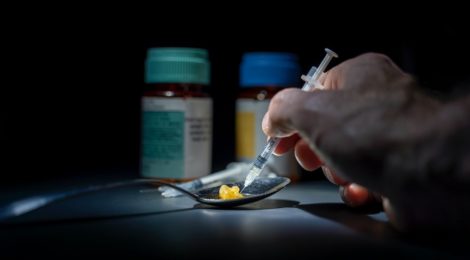
The Dwindling Frontline: What COVID-19 Has Done to America’s Drug Epidemic
Before COVID-19 arrived on American soil, there wasn’t much curiosity about how the growing epidemic could collide with another well-established one, one which had been raging for nearly two decades unchecked. Perhaps the novelty of the corona virus, and the political air that developed around it, monopolized many Americans’ attention and distracted from what was once the most salient public health emergency of the millennium. Enough time has now passed to collect and examine the data from the first few months of COVID-19’s impact, allowing us to piece together the current landscape of America’s “other” most-notable health crisis.
In April, the National Institute on Drug Abuse released one of the first warnings about how this virus may impact people with Substance Use Disorder. This article stressed the increased risk that drugs present to the individual, particularly when it comes to susceptibility for contracting the virus and difficulty recovering from it. Other authorities echoed these predictions on the subject and offered suggestions on how to find safe treatment during the pandemic. It wasn’t long before these predictions began to manifest, and the national media took minimal notice of some alarming reports of overdose death rates skyrocketing in many communities. But now, the bigger picture has become clear. From March 19 to May 19, 2020, there was a 17.59% National increase in drug overdose deaths. It’s not hard to see that this is a massive spike in an already enormous problem for a struggling nation.

When the need for substance abuse treatment services has been its highest, the availability has been sorely lacking. Rehabs across America bear the brunt of the blame for the condition of our nation’s drug problem, but they aren’t entirely at fault. In order for people to be helped by rehabs, detoxes, and outpatient counselors, they have to show up. When COVID-19 first broke out, many people in treatment up and left, and it’s easy to see why. The amount of confusion and mixed signals about what was safe and what wasn’t, led many to think for themselves and act. This meant getting out of a communal setting and returning home to their families. But for those who hadn’t completed treatment, this often involved relapse.
Beyond those individuals who left treatment and relapsed, there was an even larger group in long-term recovery that relapsed from the psychosocial pressures of the COVID-19 pandemic. Many others, who had no prior addiction history, found themselves driven to substance abuse under mounting stress and hardship. It is still unclear how badly addiction has spiked overall. The only way to come close to quantifying rates of substance use disorder come from small sample polls or by counting how many individuals reached out for help from licensed treatment services. This fails to reveal the full picture of how many people are struggling with addiction.
The disparity between the need for services and their under-utilization has created a troubling paradox: How will we keep America’s rehab centers open if no one is using them? This is particularly problematic when we consider how badly they will be needed once the virus is in check, if that day comes at all. Even if it does not, people will begin using services they’ve avoided with more regularity in the near future. And if they are all shut down, there won’t be anywhere for people to get help.
Treatment centers have taken massive hits. From January to April of 2020, 83% of responding treatment programs expressed financial losses that averaged over $21,000 each from insurance revenue. This is mainly due to a lack of clientele. Further, many treatment centers were required to invest in technology to deliver telemedicine services at the cost of over $6,000 for 73% of responding treatment centers. And almost 40% of responding centers spent over $3,000 each for Personal Protective Equipment to increase safety and adhere to rapidly developing guidelines. But perhaps the biggest hit for the nation’s rehab system was the $40,000 that nearly half of each responding program lost due to an inability to host vital fundraising events. So many rehabs are nonprofit organizations that exist to serve people, but they need income to survive.

These expenses add up. With less disposable income, they can pay less staff, so they must lay some off and cut hours. This results in a smaller workforce and diminished patient capacity. Lower capacities mean lower revenue, and the cycle becomes self-perpetuating. Add overtime pay for the few staff who remain on and can work in these high-risk environments, and it’s clear that this problem is quickly becoming a crisis in and of itself.
The obvious solution is increasing funding for America’s treatment programs and providing them with the financial relief needed to endure this trying time. But that is easier said than done, and the average person has little to no control over that kind of funding. But what can be done, in the meantime, is quite simple. Those working in the treatment field can continue to provide the dedication and quality service that people are going to need if they’re going to have a chance at recovery in today’s climate. We can continue to adapt and be on the cutting edge of new services, utilizing telemedicine and other advances. Insurance providers are making unprecedented exceptions to allow people access to services, so be sure to explore options and inquire.
For those who may not work in the treatment field, but who know or love someone who struggles with addiction, you can help too. Myths and false data abound in the recovery community. Perhaps the most dangerous is the mantra that someone cannot be helped until they are “ready.” The fact is that people die every day from drug addiction before they were ever “ready” to get help. But it doesn’t have to be that way. Intervention saves lives and exists for that sole reason. If someone is struggling with addiction, don’t watch and wait. Step up before it is too late and utilize the lifesaving treatment services that need us almost as much as we need them.
– Joseph Kertis, Guest Author
Feature: Michael Longmire at Unsplash, Creative Commons
First: GoaShape at Unsplash, Creative Commons
Second: Ian at Unsplash, Creative Commons
About the Author
Joseph Kertis is an experienced healthcare professional turned journalist. His experience in the field of substance abuse and addiction recovery provides a unique insight into one of our Nation’s most challenging epidemics. He utilizes this knowledge in his writing to give an expert viewpoint that spreads awareness through education.





This is really worrying news and surely the sector needs to bring this to further light and lobbying given the ramifications that are already potentially occurring